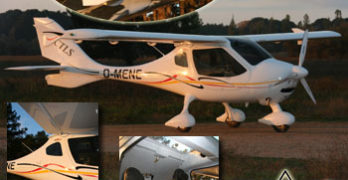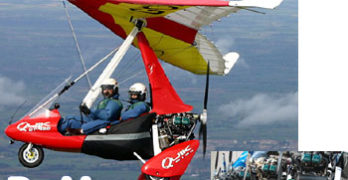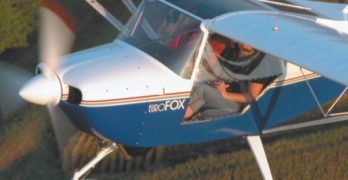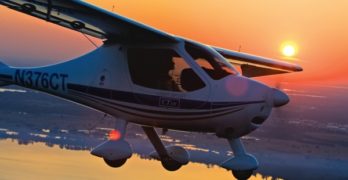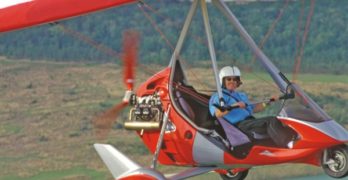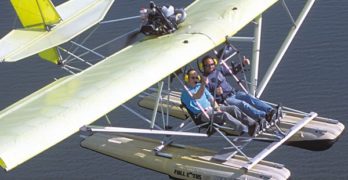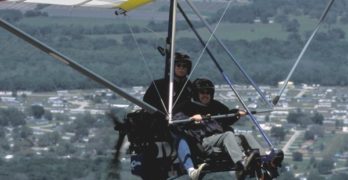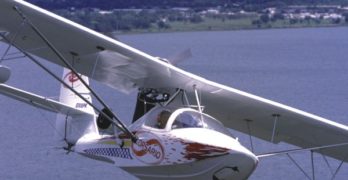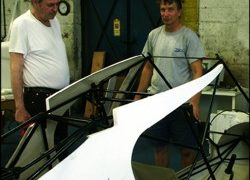Flight Design leads the LSA flock maintaining a market share of more than 20% since the start of SLSA certifications almost three years ago. Their first American export was CT2K, fine tuned in 2006 for U.S. pilots as the CTSW. Now sport pilots around the world can welcome the CTLS, the third generation of this successful design. *** Longer and sleeker, LS was lengthened 14 inches and has a list of new features. Although you can add a few options (leather seats and autopilot, for example) the base model has everything a Sport Pilot could want including Garmin radio, transponder, and GPS with XM, dual Dynon glass displays, and BRS parachute…all standard. *** The company says every mold on the all-carbon fiber aircraft was changed. You can see this in its larger cabin with aft windows, the wingtip treatment, and in a more “adult” look to the design.
Search Results for : BRS parachute
Not finding exactly what you expected? Try our advanced search option.
Select a manufacturer to go straight to all our content about that manufacturer.
Select an aircraft model to go straight to all our content about that model.
Quik Approval for UK Trikes; SLSA Numbers 60 & 61
Two weight shift aircraft from England carried the list of Special Light-Sport Aircraft past the 60 mark. Welcome to the P&M Aviation Quik and Quik GT450, our two newest SLSA models and the 7th and 8th weight shift aircraft (adding to 5 powered parachute models and 48 fixed wing airplanes, 2 of which fall into the Glider category). P&M Aviation was formed from a merger of Pegasus Aviation and Mainair Sports, the two leading UK trike builders. *** The P&M Quik models are modestly priced compared to other trikes from Europe. You can buy a Rotax 912-powered Quik for just over $50,000, which is substantially lower than other 912 trikes. The price tag also qualifies as one of the least costly SLSA. *** P&M Aviation USA is the American importer of the British brand. They’ll be at Sebring 2008 where you can see the Quik models with a larger control panel to allow for more instruments.
The EuroFox Offers Affordable Quality
Repatriate means “to restore or return to the country of origin.” That’s exactly what’s happening with the Aeropro EuroFox, an Eastern European-built light-sport aircraft (LSA) based on American design work. It’s coming to this country as a ready-to-fly LSA through importer Rollison Light Sport Aircraft (RLSA).
Just as a car made in Detroit may incorporate a considerable number of parts that were manufactured overseas, LSA can be a combination of United States- and foreign-built parts as well. That’s not unusual in the aviation world. Consider that a new Boeing airplane is likely to have many parts manufactured in other countries. When Boeing competes against Airbus, it may be important to give some work to a country that may buy billions of dollars of airliners. Therefore, even a Boeing aircraft is not 100 percent made in America.
In the LSA world, aircraft manufactured in foreign countries may be delivered to the United States without instruments or other accessory equipment, or that equipment may have been built in the United States and shipped overseas for installation in the aircraft.
Aeropro EuroFox
His Rollison Light Sport Aircraft (RLSA) company has been building a fleet of aircraft for sale from European sources. Rollison has represented numerous brands over the years he’s been involved in light-sport aviation. First he represented American brands and later European. Recently he’s traveled to South America to see what’s available. Today, Rollison sells the Remos G-3 Mirage, the Ikarus-Comco C42, and the EuroFox. He’s associated with Allistair Wilson who is making his own Astra trikes. Of the fixed-wing models in RLSA’s hangar, the EuroFox is the most modestly priced with the C42 next highest and the G-3 as RLSA’s top-of-the-line model.
More Than Familiar?
Many Ultralight Flying! readers will say the EuroFox looks to be a copy of a Kitfox. In fact, says Rob Rollison, this simply isn’t true.
The EuroFox certainly shares heritage with the Kitfox but is actually a downstream development of the Avid Flyer. In the Slovak Republic, where the four founders of Aeropro live, plans were used to build an Avid.
CT 2006…Second Generation Light-Sport Aircraft
In the 15 months since the first two special light-sport aircraft (S-LSA) were introduced
at the Sun ‘n Fun Fly-In in Lakeland, Florida, a wave of S-LSA have taken to the
sky. The number delivered to customers is approaching 500 aircraft — and climbing as
quickly as factories can produce and deliver them. The years ahead should see a sharply
increasing number of LSA flying in America.
The good news for pilots is we won’t
just have more LSA, we’ll have better
ones as designers modify and improve
aircraft based on customer input and
service history. That’s one of the benefi
ts of consensus standards versus
type certification-manufacturers
can cram more features into the airplanes
and factories may refine production
techniques without undergoing
costly recertification. The best
news is we don’t have to wait. “New
and improved” LSA are here now.
The 2006 CT
Because of its distinctive profile, the
Flight Design CT is one of the most
recognized S-LSA flying.
The Tanarg: Most Deluxe Trike Ever?
When Air Création introduced their beautiful Tanarg trike to American pilots in 2005, it earned a very warm response and, at the same time, shock at its $53,000 price tag – some $10,000 more than the next closest high-end trike.
Pronounced Tan-ARG (rhyme it with “barge,” except the G is said softly, more like TAN-arz), the machine is impressive. Even for those pilots or newcomers who regard weight-shift control trikes as “weird,” or “hard to understand,” the Tanarg design concept earns respect rapidly. This aircraft has received enormous attention to detail while also gaining in strength and ease of use. Air Création engineers built on many successful years of designing and producing lots of trikes – some 2,500 of them – to create a stunning work of aeronautical art. Nothing on the market is quite like the Tanarg.
The last time I wrote about Air Création, I talked about my experience with their wonderful new iXess wing (once again introducing a hard-to-pronounce name).
Float-Flying the M-Squared Sprint 1000
“Air in your hair!
Space on your face! A breeze on your knees!” A former colleague of mine used to repeat this short mantra to illustrate the joy of open-cockpit flying. It was catchy and engaging and his customers liked it.
With 15 Light-Sport Aircraft now possessing their FAA Special Light-Sport Aircraft (SLSA) airworthiness certificates, not a single one is open cockpit, though the IndUS Thorpedo, Legend Cub, and Tecnam Sierra can enjoy partially open cockpits.
Special Light-Sport Aircraft will eventually add more of this genre of light aircraft but one of the beauties of FAA’s new regulation is that it does not eliminate two previous categories: Amateur-built 51% kits or Part 103-compliant ultralights.
With 21¼4 years left before operators of 2-seat 496-pound empty weight ultralight exempt trainers must register in FAA’s new Light-Sport Aircraft category, and with 41¼4 years left while these machines can be used for compensated training flights, the segment still has lots of life remaining.
TC’s Trikes and North Wing Team Up on Coyote
Two years ago, I flew and reported on the only model TC’s Trikes offered. Though their line had little depth, the Tennessee company built their own wing and chassis. Many trike chassis builders purchase wings from other sources, much like happens universally in powered parachutes. TC’s Trikes did it all based particularly on their needs as an active flight school operation.
In today’s light aircraft world, a wider product line addresses more pilots, which makes a more viable business. Given the pace of refinements, it can be tough to keep up. Yet TC’s Trikes had a track record in the East, selling more than 100 trikes of their own and other brands. Pairing up with another company, if the fit was right, could be smart business.
A match was found between TC’s Trikes and Washington state-based North Wing Design. TC’s Trikes had something North Wing lacked – a presence in the Eastern USA.
Boathull Corsario Arrives in America
Brazilian Amphibious Beauty
Most Americans
are unaware of the Corsario. Importer Steven Cohen is out to change that. He and his partner, Phil Klein, are marketing this handsome amphibian, which they import from Brazil. Not a brand-new design, this is the MK5 model – it’s been through four previous iterations.
The Corsario comes from a South American company called Microleve founded in 1982, back near the beginning of the ultralight era. The company proudly states, “Aside from being the first ultralight manufacturer in Brazil, the quality of our products has made Microleve the biggest seller of ultralight aircraft in Latin America.”
In 23 years of operation, Microleve claims to have delivered more than 1,400 ultralight aircraft, including almost 20 different models, named as MX1, MX2, ML200, ML300, ML300M, ML300MF, ML400, ML400T, ML450, ML500T, CORSARIO MK1, MK2, MK3, MK4, and MK5. As you might surmise by reviewing this list, the Brazilian company has taken several of their models through a series of refinements and the Corsario is no exception.
Manufacturing Earthstar Aircraft in Israel
Avicom, Earthstar’s new partner in building Odysseys and Gull 2000s, has been
an importer and distributor of American-made aircraft in Israel for several years,
but taking on the manufacturing of an aircraft is a different enterprise. Still,
Avicom principles Miki “Mike” Raviv and Abraham “Kim” Kimchi understood that
Mark’s designs needed and deserved better manufacturing capability. They will
accomplish that goal through a partnership with Kanfit Ltd., a well-established
aerospace parts and systems manufacturer in Israel.
In May 2005, Mark and his wife,
Leslie, visited Israel to evaluate Avicom
and Kanfit. After a week of visits and
meetings, the American couple took
home a Technology Transfer Agreement
for review.
On July 18, 2005, the contracts were
signed, giving Avicom the manufacturing
and worldwide marketing rights to
the Odyssey and Gull 2000.
In late July, Mike and Kim flew with
Mark from Earthstar’s headquarters
in Santa Margarita, California, to EAA
AirVenture Oshkosh 2005 to become better
acquainted with the aircraft and the
business.
- « Previous Page
- 1
- …
- 11
- 12
- 13
- 14
- 15
- …
- 18
- Next Page »


